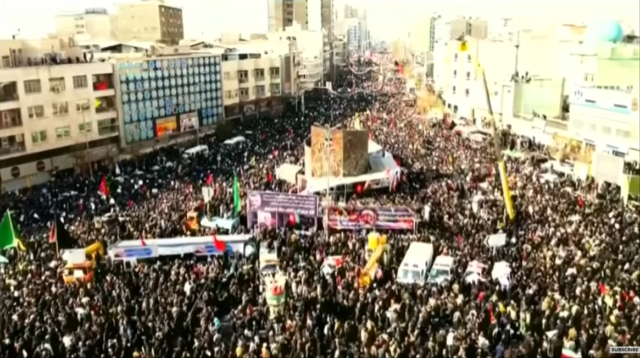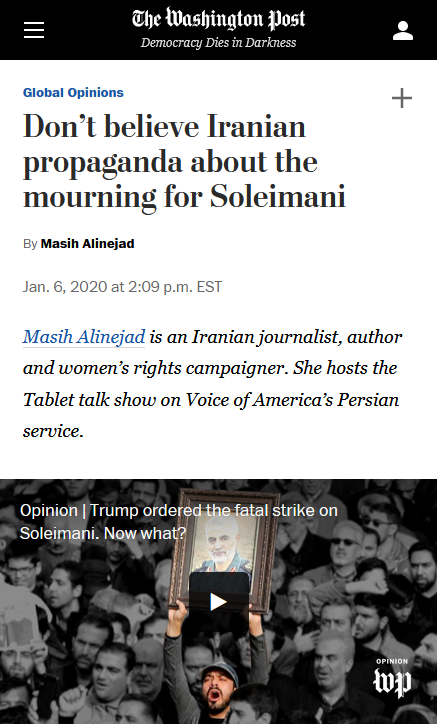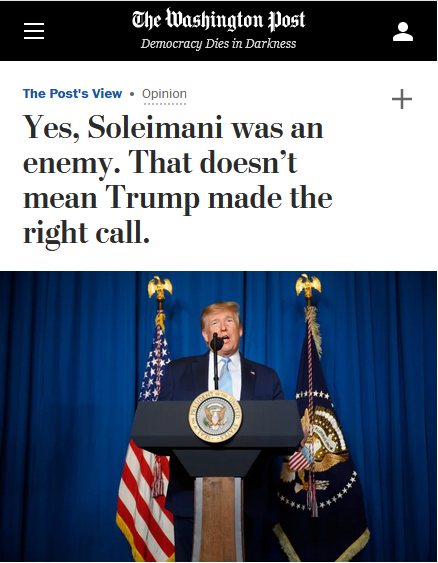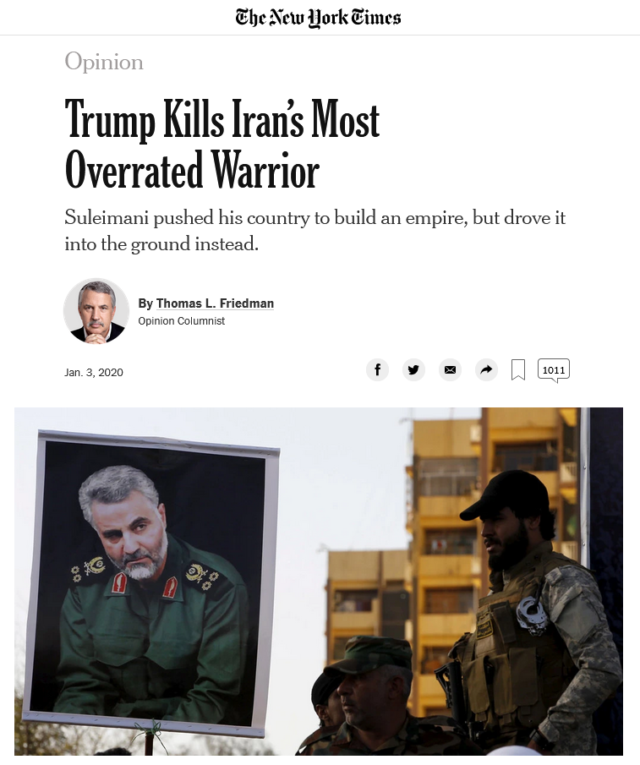From Resistance to Assistance: Little Pushback to Trump’s Iran Assassination
MEDIA, 13 Jan 2020
Alan MacLeod | FAIR-Fairness & Accuracy In Reporting – TRANSCEND Media Service
9 Jan 2020 – After Donald Trump’s election, both the New York Times and Washington Post saw huge jumps in subscribers, all hoping that the outlets would hold the president to account. Both papers tapped into this sentiment: In February 2017, the Post adopted the motto “Democracy Dies in Darkness” on its masthead; Times ads have used the slogan, “The truth is more important now than ever.”
Trump has played his part, attacking media that bother him as “failing,” and reportedly telling all federal agencies in October to cancel their Times and Post subscriptions.
Yet when the president does indeed carry out dangerous, aggressive actions, such as the assassination of Iranian general and political leader Qassem Soleimani in Baghdad on January 3, “resistance” turns to assistance from the corporate press. FAIR studied every editorial and opinion piece on Soleimani’s killing published by the two newspapers, from the attack until January 7 (around three dozen articles), and found their pushback to Trump’s actions to be distinctly limited.
 Some of the millions of people (BBC, 1/6/20) who turned out for the funeral of Qassem Soleimani, whom no one thought “was a great guy the world will miss” (New York Times, 1/7/20).
Some of the millions of people (BBC, 1/6/20) who turned out for the funeral of Qassem Soleimani, whom no one thought “was a great guy the world will miss” (New York Times, 1/7/20).
‘Indisputably an enemy’
Opinion writers and editorial boards took great pains to emphasize the disgust and contempt they held for Soleimani, a “terrorist mastermind” (Washington Post, 1/6/20) “as evil as Osama bin Laden and Abu Bakr al-Bahdadi” (Washington Post, 1/3/20). As Gail Collins wrote in the New York Times (1/7/20), “There seems to be a wide range of opinions about Soleimani, none of which are that he was a great guy the world will miss.” The millions of people who attended his funeral may beg to differ; two-thirds of Iranians rated him “very favorably,” according to a 2018 University of Maryland poll.
Some people in Lebanon and Yemen who received his support against foreign aggression, and citizens of Iraq and Syria who no longer live under the ISIS caliphate he helped defeat, may also have a perspective on Soleimani that went largely unrepresented in leading US papers. As Noam Chomsky (Truthout, 1/7/20) remarked of Iraqi Kurds:
They have not forgotten that when the huge, heavily armed US-trained Iraqi army quickly collapsed, and the Kurdish capital of Erbil, then Baghdad and all of Iraq were about to fall in the hands of ISIS, it was Soleimani and the Iraqi Shia militias he organized that saved the country.
There was little deviation in the Times or Post from the idea that Soleimani was an “evil” (New York Times, 1/3/20, 1/7/20; Washington Post, 1/6/20), “blood-soaked” (New York Times, 1/4/20) “terrorist” (New York Times, 1/3/20) who “had it coming” (New York Times, 1/4/20), a monster comparable to Nazi Holocaust leaders (Washington Post, 1/6/20). For New York Times columnist Bret Stephens (1/3/20), certain Nazis were, in fact, too good to be compared to Soleimani: “To think of him as a worthy adversary — an Iranian Erwin Rommel — is wrong,” he wrote. Meanwhile, Thomas Friedman (New York Times, 1/3/20) labeled him “the dumbest man in Iran and the most overrated strategist in the Middle East.”
 Don’t believe Iranian propaganda, says an employee of the US propaganda service (Washington Post, 1/6/20).
Don’t believe Iranian propaganda, says an employee of the US propaganda service (Washington Post, 1/6/20).
The chief reason for Soleimani’s nefariousness, the Times editorial board (1/3/20) explained, was that he was “indisputably an enemy of the American people…and an architect of international terrorism responsible for the deaths of hundreds of Americans.” The claim that Soleimani had killed hundreds of Americans was repeated, word for word, in many articles in the papers of record (e.g., New York Times, 1/7/20; Washington Post, 1/3/20, 1/3/20) as well as across the media (e.g., Boston Globe, 1/3/20; Fox News, 1/6/20; The Hill, 1/7/20).
These “hundreds of Americans” were US forces killed by improvised explosive devices (IEDs) during the Iraq War, supposedly made in Iran and planted by Iranian-backed Shia militias. As professor Stephen Zunes pointed out in the Progressive (1/7/20), the Pentagon provided no evidence that Iran made the IEDs, other than the far-fetched claim that they were too sophisticated to be made in Iraq—even though the US invasion had been justified by claims that Iraq had an incredibly threatening WMD program. The made-in-Iran claim, in turn, was the main basis for pinning responsibility for IED attacks on Shia militias—which were, in any case, sanctioned by the Iraqi government, making Baghdad more answerable for their actions than anyone in Tehran. Last year, Gareth Porter reported in Truthout, (7/9/19) that the claim that Iran was behind the deaths of US troops was part of Vice President Dick Cheney’s plan to build a case for yet another war.
Even if one is inclined, against all experience, to take US claims about an official enemy on faith, the language that Soleimani killed “hundreds of Americans” is a deliberately nebulous. American what—children? Civilians? Indeed not. The allegation is that he targeted US troops or “contractors”—i.e., mercenaries—stationed not at home, but in a region on the other side of the world that the US illegally attacked and has occupied for most of this century. “Soleimani provided effective military resistance to foreign occupying forces,” though, sounds very different from “killed hundreds of Americans.”
 In a characteristic formulation, the Washington Post (1/3/20) argued that Soleimani was “an implacable enemy of the United States” responsible for “countless atrocities”—but complained that Trump “has yet to offer any explanation” of why his killing was “in America’s strategic interest.”
In a characteristic formulation, the Washington Post (1/3/20) argued that Soleimani was “an implacable enemy of the United States” responsible for “countless atrocities”—but complained that Trump “has yet to offer any explanation” of why his killing was “in America’s strategic interest.”
Minor quibbles about protocol
In the papers studied, the majority of articles carried a similar, cookie-cutter structure: agree that Soleimani was a bad guy and deserved to be killed, but worry about the consequences and criticize the president on technical grounds. The Times’ editorial board (1/3/20) wrote that “the real question” wasn’t whether Soleimani’s killing “was justified, but whether it was wise.” Meanwhile, the Post (1/3/20) made exactly the same point: “Yes, Soleimani Was an Enemy,” the editorial board declared. “That Doesn’t Mean Trump Made the Right Call.”
Criticism of the government’s actions was largely limited to worrying it might escalate tensions and spark a hot war—something for which US corporate media have been laying the groundwork for months (FAIR.org, 7/2/19) if not years (Extra!, 3/12). Complaints included that the US lacked a clear grand strategy (New York Times, 1/7/20), that it was a “rash and shortsighted” (Washington Post, 1/6/20), that there were “no more adults in the room” (New York Times, 1/6/20), that it would “bolster” the Iranian regime (New York Times, 1/6/20) or could “trigger a bigger conflict” (Washington Post, 1/3/20) that risks “ensnaring” the US in a wider encounter (Washington Post, 1/6/20). (In corporate media mythology, the United States is always an innocent party getting accidentally trapped into going to war, rather than actively pursuing it—FAIR.org, 6/22/17.)
The Times and Post offered some meager objections based on congressional technicalities. “Why didn’t the White House alert senior Democrats in Congress, including Speaker Nancy Pelosi?” asked the Times (1/3/20). The Post (1/6/20, 1/6/20) made similar criticisms, as if had Trump done so, there would be no legal issues with killing a foreign leader in another country.
There were some exceptions. Law scholar Karen Greenberg (New York Times, 1/6/20) wrote that the general’s killing was illegal and an “inevitable outcome of our dangerous ‘war on terror’ policy.” Iranian-American writer Azadeh Moaveni worried about the effect of war on Iran and noted that Soleimani was considered a “war hero” inside the Islamic Republic (New York Times, 1/6/20).
Opposition to war from the Times’ regular columnists was more about who was carrying it out. Michelle Goldberg (1/6/20), condemning Trump’s “unstable” actions, presented Gen. James “Mad Dog” Mattis as a moderating force, although she did note that, “To Iranians, after all, America is the aggressor.” Paul Krugman (1/6/20), meanwhile, acknowledged that Iranians would not accept Trump’s right to kill their leaders, but also claimed that before Trump, the US was “relatively trustworthy” and “clearly stood for global rule of law,” always behaving as “no more than first among equals.”
But across the spectrum of dozens of articles in America’s two most influential newspapers, there was little difference in outlook. Contempt for the commander in chief? Sure. But scrutiny of the state? Not so much. As Stephens reminded Times readers, “What shouldn’t be in doubt is the justice.”
 America’s most overrated columnist was not impressed (New York Times, 1/3/20).
America’s most overrated columnist was not impressed (New York Times, 1/3/20).
Embarrassing predictions
With all the confidence of White Star Line Executives in 1912 proclaiming HMS Titanic unsinkable, opinion columnists in our most influential media made a number of utterly terrible predictions or assertions that were immediately disproven.
The Times editorial board, echoing official claims, wrote that Soleimani likely “had come to Iraq in part to plot the next move against United States military personnel or civilians.” In reality, he had been invited to attend regional peace talks with Saudi Arabia by the Iraqi prime minister, who had personally asked Trump for permission for Soleimani to attend. Trump agreed, then used the opportunity to assassinate him.
Less than two days later, the Iraqi parliament voted overwhelmingly to expel all US forces from Iraq, which made Times top columnist Thomas Friedman’s assertion that protests against the US embassy in Baghdad were staged to “make it look as if Iraqis wanted America out when in fact it was the other way around” seem distinctly foolish.
Meanwhile, both the Post (1/3/20) and the Times (1/3/20) published articles confidently predicting that “the killing will have the effect of deterring further Iranian attacks on Americans, such as the rocket strike that killed a US contractor at an Iraqi base last week,” and that Iran “will prefer to tread lightly,” with the assassination “bring[ing] a sense of realism to the Islamic Republic’s thinking.” Needless to say, the dozens of Iranian rockets raining down on US bases in Iraq have proven these predictions woefully incorrect.
While corporate media like to present themselves as holding the current administration to account, in reality they offer little meaningful resistance to its foreign policy adventures. As with Trump’s efforts to overthrow the governments of Venezuela and Bolivia (see FAIR.org, 1/25/19, 11/15/19, 11/26/19), media are essentially lining up shoulder to shoulder with the president. When it comes to opposing or even questioning an aggressive foreign policy, the resistance™ is useless.
________________________________________________
Alan MacLeod @AlanRMacLeod is a member of the Glasgow University Media Group. His latest book, Bad News from Venezuela: 20 Years of Fake News and Misreporting, was published by Routledge in April.
Tags: Iran, Journalism, Media, USA, War Journalism
DISCLAIMER: The statements, views and opinions expressed in pieces republished here are solely those of the authors and do not necessarily represent those of TMS. In accordance with title 17 U.S.C. section 107, this material is distributed without profit to those who have expressed a prior interest in receiving the included information for research and educational purposes. TMS has no affiliation whatsoever with the originator of this article nor is TMS endorsed or sponsored by the originator. “GO TO ORIGINAL” links are provided as a convenience to our readers and allow for verification of authenticity. However, as originating pages are often updated by their originating host sites, the versions posted may not match the versions our readers view when clicking the “GO TO ORIGINAL” links. This site contains copyrighted material the use of which has not always been specifically authorized by the copyright owner. We are making such material available in our efforts to advance understanding of environmental, political, human rights, economic, democracy, scientific, and social justice issues, etc. We believe this constitutes a ‘fair use’ of any such copyrighted material as provided for in section 107 of the US Copyright Law. In accordance with Title 17 U.S.C. Section 107, the material on this site is distributed without profit to those who have expressed a prior interest in receiving the included information for research and educational purposes. For more information go to: http://www.law.cornell.edu/uscode/17/107.shtml. If you wish to use copyrighted material from this site for purposes of your own that go beyond ‘fair use’, you must obtain permission from the copyright owner.



The Ukranian plane crash stinks !
As soon as the Iranian BM were in the air – the Iranians would and should have closed their airspace ! Why did they not do it ? It takes a second.
That the Ukranian plane veered to the IRG HQ near the airport,or that the radar or transponder pods,on the plane were off or put off – is all bullshit.The Iranian ADS would know all the commercial flight schedules of the day,and would also know the RCS of a Boeing,and the time of its takeoff (from its own airport!).
Even if the Americans jets were to make a raid into Iran – the ADS at the land border,would pick them up and the jets would fly at 20-25000 feet.The Ukranian plane was at take off stage -less than 10000 feet.How could the Iranian ADS at Tehran,assume that the projectile was a Cruise Missile – at low altitude ?
American jets were in the air in Iraq,even before the BM launch by Iran – and must have been tracked by the Iranian ADS and Radars.
Not 1 American Killed in the Ukranian Flight ! Not 1 EU killed in the flight ! 90% were Iranians ! That is why the Iranians came out on the streets – AS IRANIANS WERE KILLED ON THE FLIGHT !
Ain’t no coincidence ! It is the Americans who might have jammed the communications between the flight and the Iranian ADS – and also jammed the Iranian ADS – to cause the Iranian Hit ! The aim was to discredit the IRG and the Iranian Elite – by making the Persians kill Persians on Persian Soil – blowing the myths around the Quds,Basij, IRG and the clergy – and start a Tahrir !
There can be no other reason ! Americans can jam any Iranian ADS – except the S-400 systems – as also,proven by the IAF raids in Syria – right upto the Syrian Presidential Palace.The Yankii hacked the Iranian Nuke enrichment plants – hacking into the Being coordinates and radars,would be a cakewalk.
Iranians/Russians allow the killing of Soleimani , Iranians Miss all the targets in Iraq , Do not close their airspace after launching of BM AND SHOOT DOWN A NATO PLANE FULL OF IRANIANS – with no American or EU casualties !
S-T-I-N-K !
During Indo-Pak conflict in 2019 the Hindoo worms shot their own chopper near the IB.That was due intense radar clutter and noise and EW from both sides of the border.dindooohindoo
The Ukranian plane was shot 10000 feet in the air – in TEHRAN, hundreds of miles from the IB with Iraq ! And there is a complete RECORDING by some human on the ground – who was there at the right time and right place. 2 Missiles were fired ! TWO ! The 2nd was to make sure – a MAN behind the MANPAD !